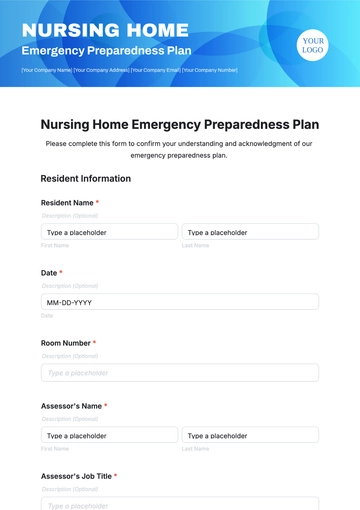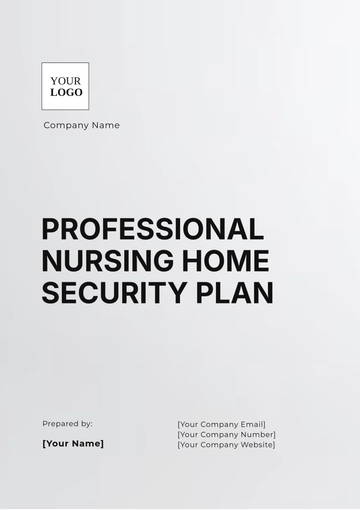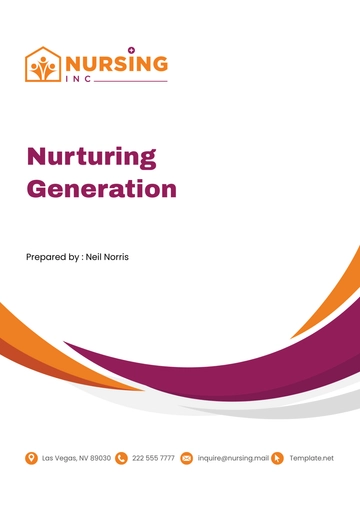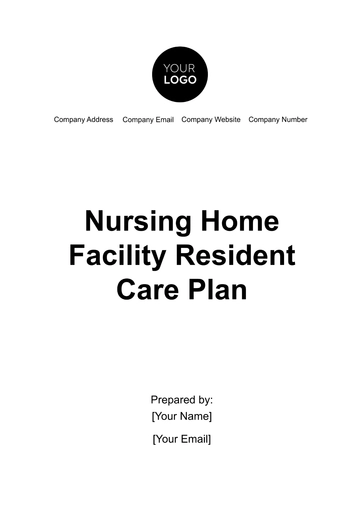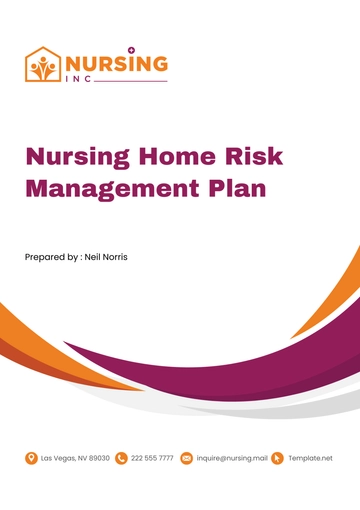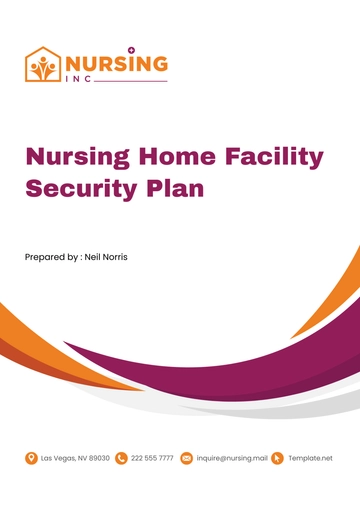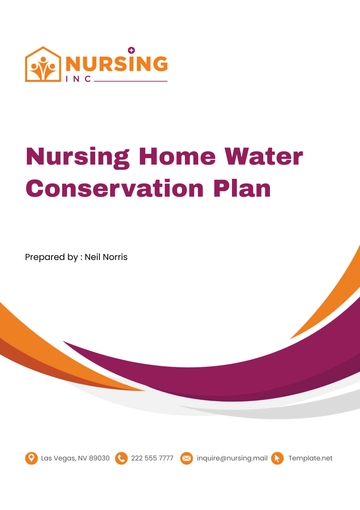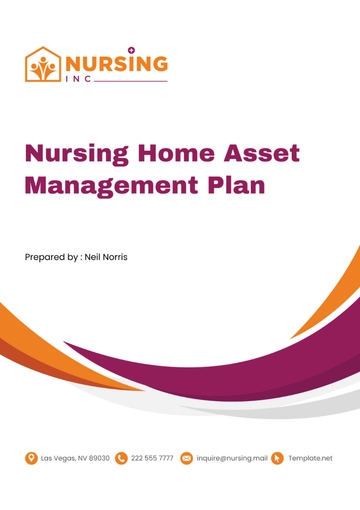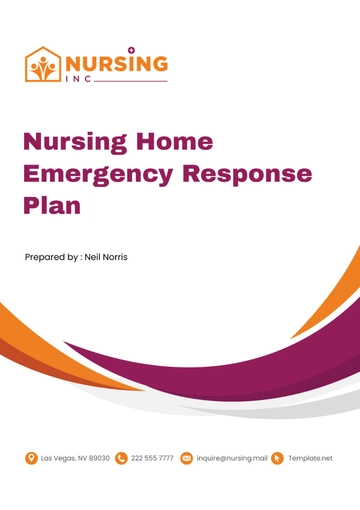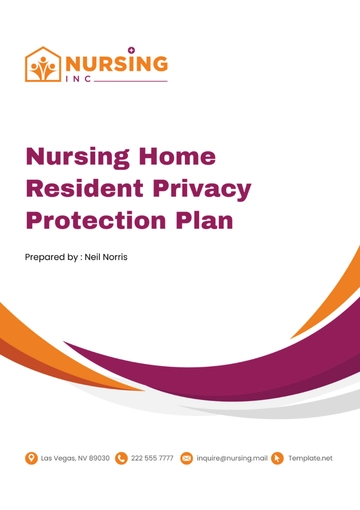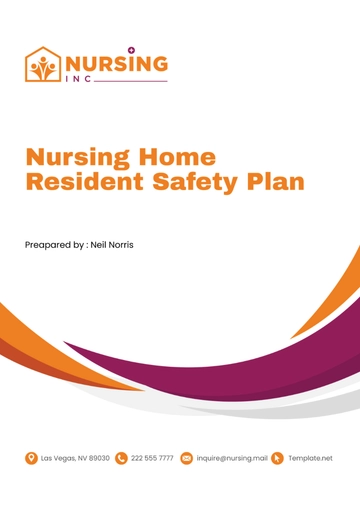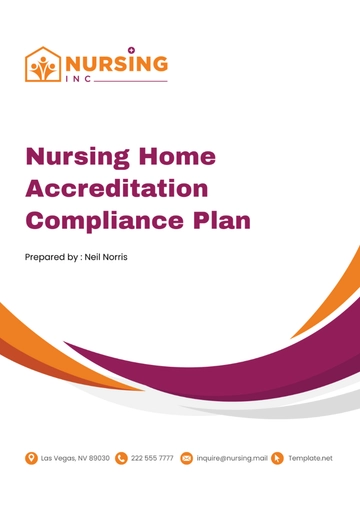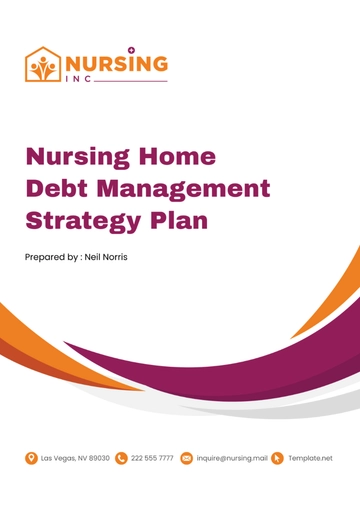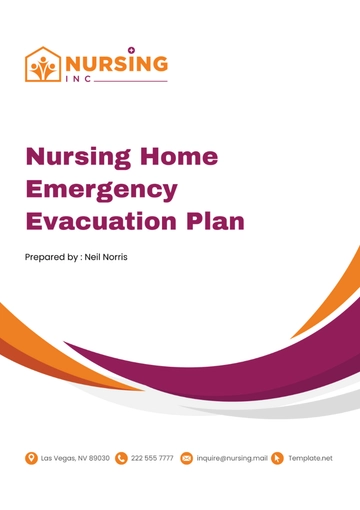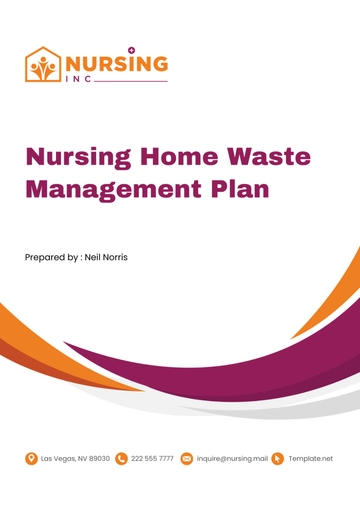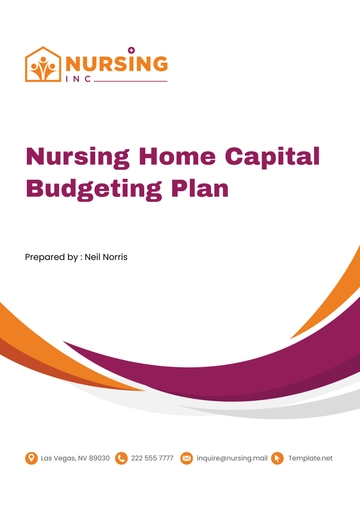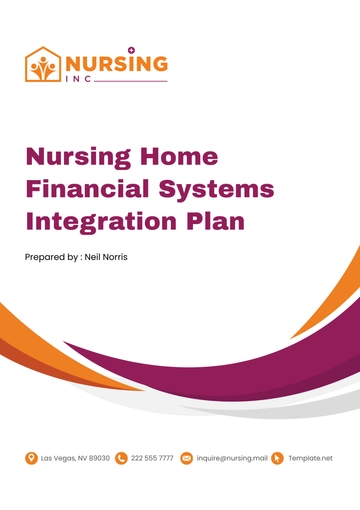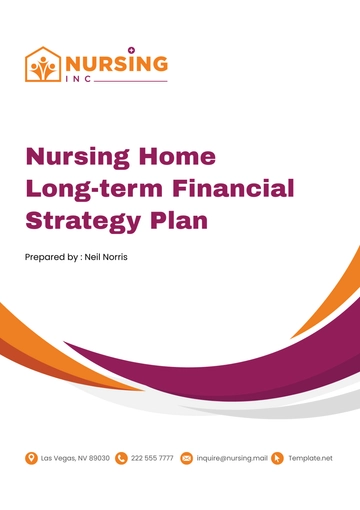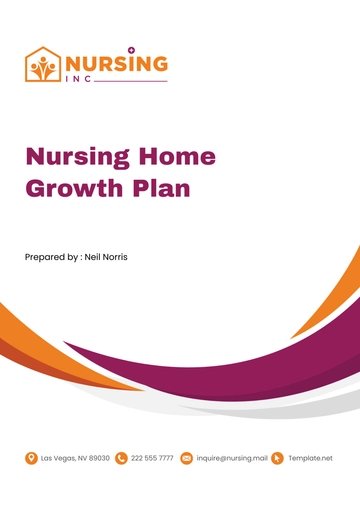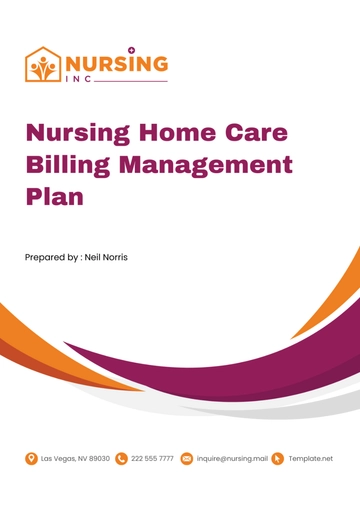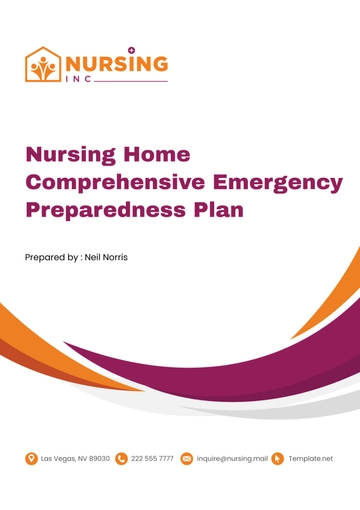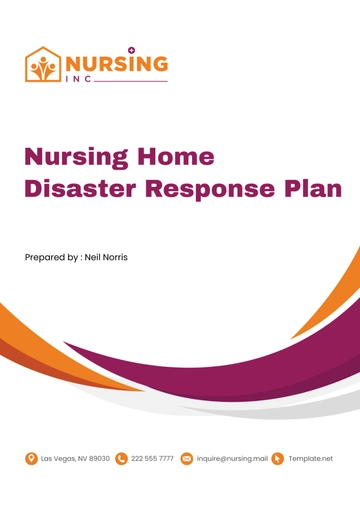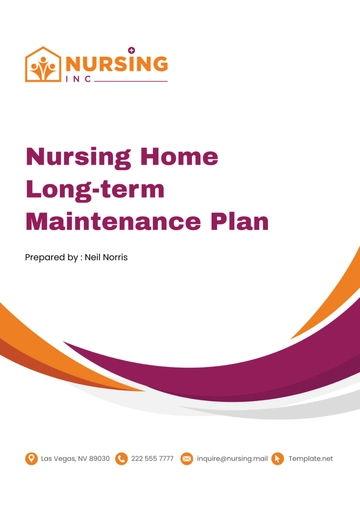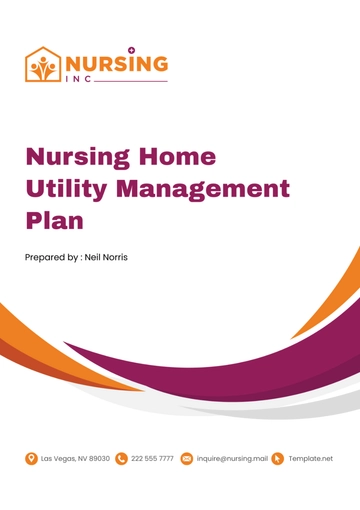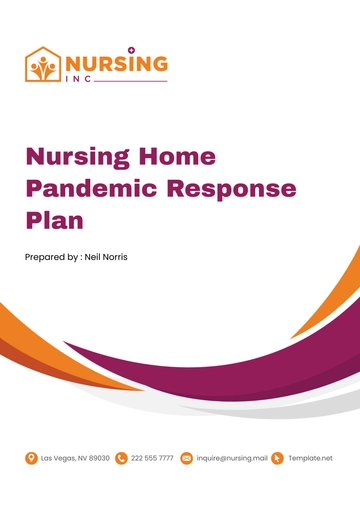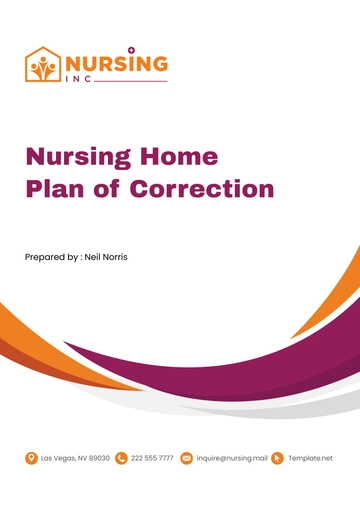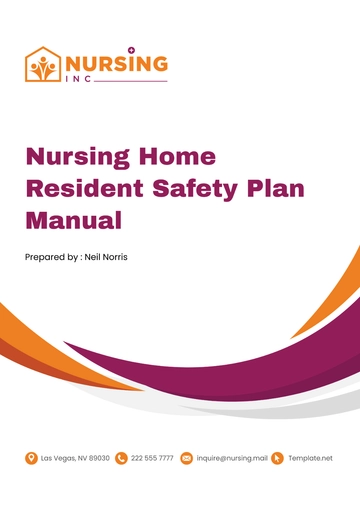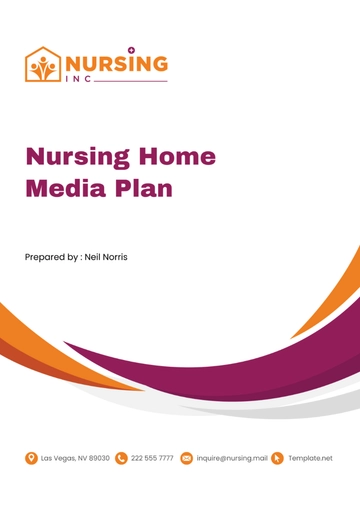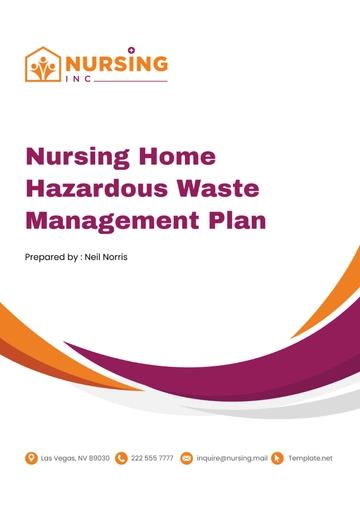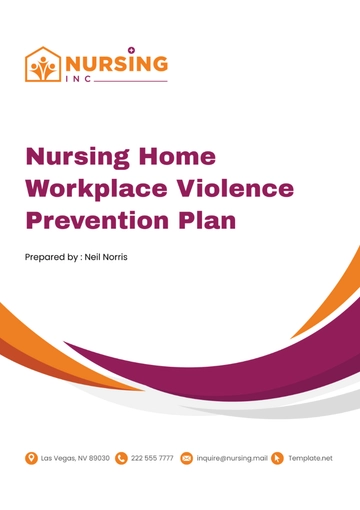Free Nursing Home Emergency Plan
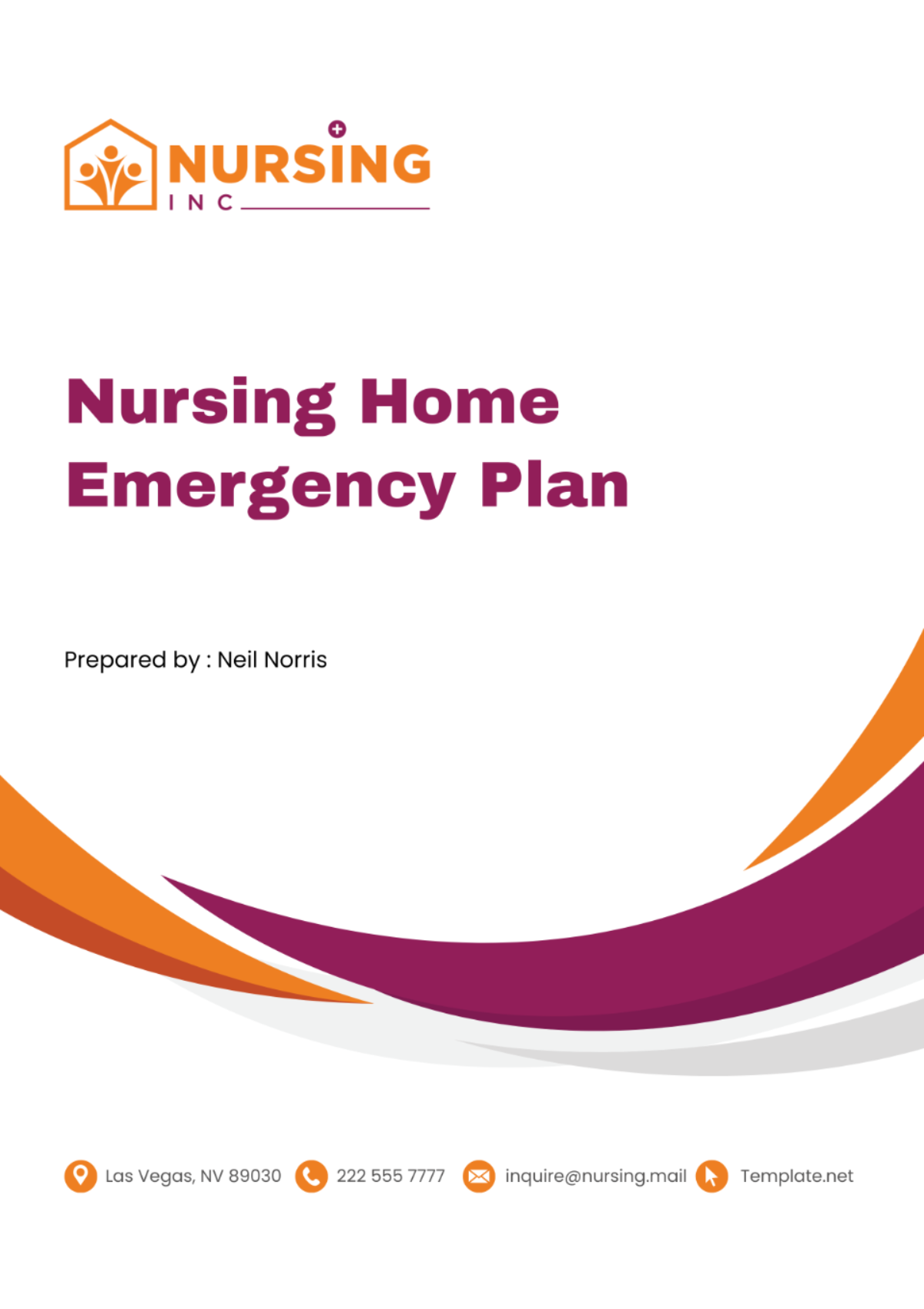
A. Introduction and Purpose
Welcome to the Nursing Home Emergency Plan, a critical document designed to safeguard the lives and welfare of residents, staff, and visitors during unforeseen emergencies. In our commitment to providing exceptional care, preparedness is paramount. This plan serves as our blueprint for proactive response and coordinated action, ensuring the highest standards of safety and security in our facility.
At the heart of this plan is our dedication to meticulous planning and clear communication. By delineating comprehensive procedures and assigning specific responsibilities to key personnel, we aim to minimize risks and mitigate potential hazards effectively. Through regular review and refinement, we continuously strive to uphold regulatory compliance and align with best practices in emergency management. Together, we stand ready to face any challenge, reaffirming our unwavering commitment to the well-being of our residents and the integrity of our community.
B. Emergency Management Team
The prime responsibility of managing emergencies lies with a dedicated Emergency Management Team that consists of administrators, department heads, frontline staff, and healthcare professionals. Each team member has defined roles and responsibilities to be executed in case of emergencies. This team is trained to respond to various types of emergencies.
Name | Position | Emergency Role |
|---|---|---|
Executive Director | Administrator | Overall Charge |
Nursing Director | Department Head | Medical Triage/Response |
Social Services Director | Interdepartmental Coordinator | Family Notifications |
Environmental Services Director | Department Head | Facility Security/Logistics |
Food Services Director | Department Head | Ensuring Food/Water Supply |
C. Emergency Procedures
In the face of unexpected incidents, meticulous planning is essential to ensure the safety and well-being of our residents, staff, and visitors. The Emergency Procedures section of our Nursing Home Emergency Plan provides clear and concise guidelines for various emergency scenarios. From evacuation protocols to communication procedures and medical emergency handling, these protocols are designed to facilitate efficient and effective emergency response, safeguarding lives and minimizing risks.
Emergency Scenario | Protocol |
|---|---|
Evacuation |
|
Communication |
|
Staff Responsibilities |
|
Severe Weather Conditions |
|
Fire |
|
D. Communication Plan
Effective communication is the cornerstone of our emergency preparedness efforts, ensuring timely dissemination of critical information to all stakeholders. Our Communication Plan encompasses a range of strategies and technologies to facilitate clear and concise communication during emergencies.
Intercommunication Systems
Intercoms: Installed throughout the facility, intercom systems provide instant communication for facility-wide announcements and updates.
Two-Way Radios: Essential for staff communication, two-way radios enable real-time coordination and response during emergencies, allowing for swift decision-making and resource allocation.
Mass Notifications
Mass Notification Systems: Utilizing dedicated software or platforms, mass notification systems enable rapid dissemination of alerts and instructions to all residents, staff, and visitors.
Phone Trees: A hierarchical system of phone contacts ensures cascading communication, with designated individuals responsible for relaying messages to predefined groups.
Mobile Applications
Emergency Alert Apps: Leveraging mobile applications, residents, staff, and family members receive instant alerts and updates on their smartphones, keeping them informed and connected during emergencies.
Text Messaging Services: SMS alerts provide an additional layer of communication, reaching individuals who may not have access to smartphones or internet connectivity.
Information Dissemination
Current Situation Updates: Regular updates on the evolving situation, actions taken, and instructions to be followed are communicated via multiple channels to ensure clarity and consistency.
Instructions and Guidance: Clear and concise instructions are provided to guide residents, staff, and visitors on appropriate actions to take based on the nature of the emergency.
Training and Familiarization
Staff Training: Comprehensive training programs ensure that staff members are proficient in utilizing communication systems and following established protocols during emergencies.
Drills and Exercises: Regular drills and exercises simulate emergency scenarios, allowing for practice and refinement of communication procedures.
E. Emergency Supplies and Equipment
In times of crisis, the availability of emergency supplies and equipment is paramount to ensuring the safety and well-being of our residents and staff. Our Nursing Home Emergency Plan prioritizes the maintenance of a robust inventory of essential resources, including medical supplies, food, water, backup power sources, and communication devices. By ensuring the ready availability of these resources, we enhance our preparedness and ability to respond swiftly and effectively to any emergency situation.
Emergency Supplies and Equipment | Description |
|---|---|
Medical Supplies |
|
Food and Water |
|
Secondary Power Sources |
|
Communication Devices |
|
F. Training and Drills
Ensuring staff readiness and competency through training and drills is fundamental to the successful implementation of our Emergency Plan. This section outlines our commitment to conducting scheduled drills, providing comprehensive training programs, and continuously assessing and improving our preparedness for emergencies.
Training and Drills | Description |
|---|---|
Scheduled Drills | Regularly scheduled emergency drills simulate various scenarios, allowing staff to practice response procedures and familiarize themselves with evacuation routes |
Comprehensive Training | Staff members undergo thorough training on emergency protocols, including evacuation procedures, first aid, and communication protocols |
Periodic Assessment | Regular evaluations and debriefings following drills and training sessions identify strengths, weaknesses, and areas for improvement |
Ongoing Improvement Efforts | Feedback from drills and training sessions inform updates and revisions to the Emergency Plan, ensuring alignment with best practices and regulatory requirements |
G. Involvement of Residents and Families
While it is undeniable that the staff and management play an instrumental role in responding to emergency situations, it is equally important to closely involve the residents and their families in this process whenever it is feasible. The residents and their families should not only be kept informed and updated regarding the emergency plans and procedures but should also be provided instructions on the appropriate ways to react during such crises. This not only involves them in the emergency response process, but also empowers and enables them to be active participants rather than passive victims. Furthermore, building a clear understanding and awareness about what to expect and how to respond during emergencies among the residents and their families can greatly contribute towards minimizing panic, confusion and chaos during real-life situations, thus promoting a more coordinated and effective overall response.
H. Partnering with Emergency Services
Partnering with local emergency services is an integral component of our comprehensive Emergency Plan. By forging strong relationships and open lines of communication with fire departments, hospitals, and law enforcement agencies, we bolster our readiness to effectively respond to emergencies. These partnerships enable us to access additional resources, expertise, and support during critical situations, ultimately enhancing the safety and well-being of our residents and staff.
Regular meetings and coordination efforts with emergency service providers are essential for fostering collaboration and ensuring mutual understanding of roles and responsibilities. By proactively engaging with these entities, we can streamline emergency response efforts, optimize resource allocation, and facilitate a cohesive and coordinated approach to managing crises. Additionally, establishing rapport with local emergency responders cultivates a sense of community resilience, reinforcing our collective commitment to safeguarding lives and property.
Furthermore, maintaining open lines of communication and sharing pertinent information with emergency services enhance situational awareness and facilitate swift decision-making during emergencies. Through ongoing dialogue and collaboration, we can adapt our emergency response strategies to evolving threats and emerging challenges, ensuring our readiness to address a wide range of contingencies effectively. Together, with our partners in emergency services, we stand prepared to confront any adversity and uphold the highest standards of safety and care within our facility.
I. Recovery and Continuity
Recovery and continuity planning are indispensable components of our Emergency Plan, ensuring that we can swiftly rebound from emergencies and maintain seamless care and services for our residents. Following an emergency, our focus extends beyond immediate response to encompass the restoration of normalcy and the provision of ongoing support to affected individuals.
Central to our recovery efforts is the thorough assessment of damages and impacts, allowing us to prioritize restoration activities and allocate resources effectively. In addition to physical repairs, we prioritize the emotional and medical well-being of our residents and staff, offering psychological support and medical assistance as needed. By addressing the holistic needs of those affected, we strive to foster resilience and facilitate their journey toward recovery.
Furthermore, our commitment to continuity of care and services drives us to expedite the resumption of normal operations without compromising quality or safety. Through proactive planning and swift action, we aim to minimize disruptions and uphold our commitment to providing exceptional care to our residents. With resilience and compassion as our guiding principles, we endeavor to emerge from emergencies stronger and more prepared than before, ensuring the continued well-being of our community.
- 100% Customizable, free editor
- Access 1 Million+ Templates, photo’s & graphics
- Download or share as a template
- Click and replace photos, graphics, text, backgrounds
- Resize, crop, AI write & more
- Access advanced editor
Ensure preparedness with the Nursing Home Emergency Plan Template from Template.net. This editable and customizable template outlines comprehensive strategies for responding to various emergencies, safeguarding the safety of residents and staff. Editable in our Ai Editor Tool, it's essential for proactive planning, establishing clear roles and procedures, and maintaining a secure environment in your nursing home.
You may also like
- Finance Plan
- Construction Plan
- Sales Plan
- Development Plan
- Career Plan
- Budget Plan
- HR Plan
- Education Plan
- Transition Plan
- Work Plan
- Training Plan
- Communication Plan
- Operation Plan
- Health And Safety Plan
- Strategy Plan
- Professional Development Plan
- Advertising Plan
- Risk Management Plan
- Restaurant Plan
- School Plan
- Nursing Home Patient Care Plan
- Nursing Care Plan
- Plan Event
- Startup Plan
- Social Media Plan
- Staffing Plan
- Annual Plan
- Content Plan
- Payment Plan
- Implementation Plan
- Hotel Plan
- Workout Plan
- Accounting Plan
- Campaign Plan
- Essay Plan
- 30 60 90 Day Plan
- Research Plan
- Recruitment Plan
- 90 Day Plan
- Quarterly Plan
- Emergency Plan
- 5 Year Plan
- Gym Plan
- Personal Plan
- IT and Software Plan
- Treatment Plan
- Real Estate Plan
- Law Firm Plan
- Healthcare Plan
- Improvement Plan
- Media Plan
- 5 Year Business Plan
- Learning Plan
- Marketing Campaign Plan
- Travel Agency Plan
- Cleaning Services Plan
- Interior Design Plan
- Performance Plan
- PR Plan
- Birth Plan
- Life Plan
- SEO Plan
- Disaster Recovery Plan
- Continuity Plan
- Launch Plan
- Legal Plan
- Behavior Plan
- Performance Improvement Plan
- Salon Plan
- Security Plan
- Security Management Plan
- Employee Development Plan
- Quality Plan
- Service Improvement Plan
- Growth Plan
- Incident Response Plan
- Basketball Plan
- Emergency Action Plan
- Product Launch Plan
- Spa Plan
- Employee Training Plan
- Data Analysis Plan
- Employee Action Plan
- Territory Plan
- Audit Plan
- Classroom Plan
- Activity Plan
- Parenting Plan
- Care Plan
- Project Execution Plan
- Exercise Plan
- Internship Plan
- Software Development Plan
- Continuous Improvement Plan
- Leave Plan
- 90 Day Sales Plan
- Advertising Agency Plan
- Employee Transition Plan
- Smart Action Plan
- Workplace Safety Plan
- Behavior Change Plan
- Contingency Plan
- Continuity of Operations Plan
- Health Plan
- Quality Control Plan
- Self Plan
- Sports Development Plan
- Change Management Plan
- Ecommerce Plan
- Personal Financial Plan
- Process Improvement Plan
- 30-60-90 Day Sales Plan
- Crisis Management Plan
- Engagement Plan
- Execution Plan
- Pandemic Plan
- Quality Assurance Plan
- Service Continuity Plan
- Agile Project Plan
- Fundraising Plan
- Job Transition Plan
- Asset Maintenance Plan
- Maintenance Plan
- Software Test Plan
- Staff Training and Development Plan
- 3 Year Plan
- Brand Activation Plan
- Release Plan
- Resource Plan
- Risk Mitigation Plan
- Teacher Plan
- 30 60 90 Day Plan for New Manager
- Food Safety Plan
- Food Truck Plan
- Hiring Plan
- Quality Management Plan
- Wellness Plan
- Behavior Intervention Plan
- Bonus Plan
- Investment Plan
- Maternity Leave Plan
- Pandemic Response Plan
- Succession Planning
- Coaching Plan
- Configuration Management Plan
- Remote Work Plan
- Self Care Plan
- Teaching Plan
- 100-Day Plan
- HACCP Plan
- Student Plan
- Sustainability Plan
- 30 60 90 Day Plan for Interview
- Access Plan
- Site Specific Safety Plan
